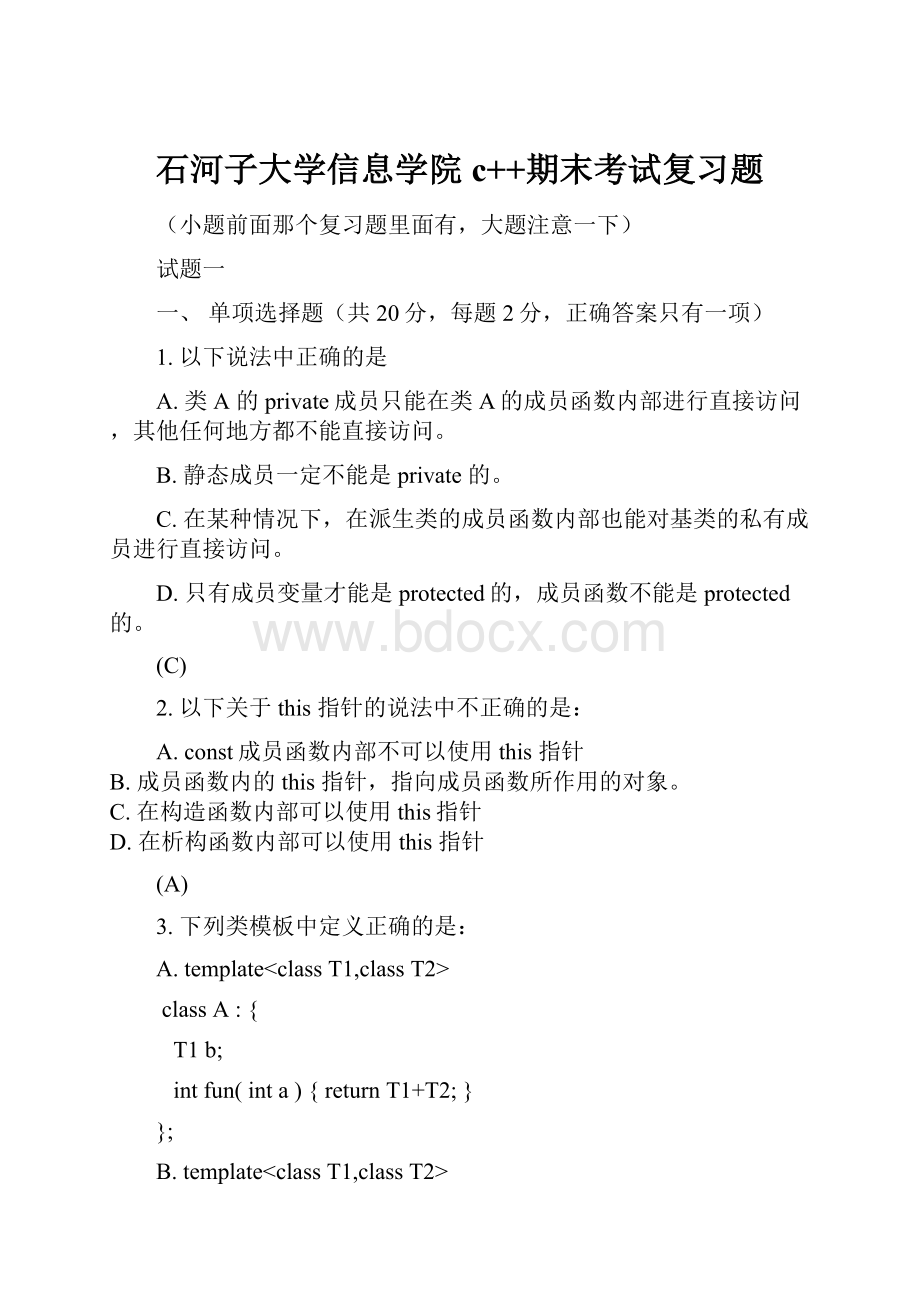石河子大学信息学院c++期末考试复习题.docx
《石河子大学信息学院c++期末考试复习题.docx》由会员分享,可在线阅读,更多相关《石河子大学信息学院c++期末考试复习题.docx(70页珍藏版)》请在冰豆网上搜索。

石河子大学信息学院c++期末考试复习题
(小题前面那个复习题里面有,大题注意一下)
试题一
一、单项选择题(共20分,每题2分,正确答案只有一项)
1.以下说法中正确的是
A.类A的private成员只能在类A的成员函数内部进行直接访问,其他任何地方都不能直接访问。
B.静态成员一定不能是private的。
C.在某种情况下,在派生类的成员函数内部也能对基类的私有成员进行直接访问。
D.只有成员变量才能是protected的,成员函数不能是protected的。
(C)
2.以下关于this指针的说法中不正确的是:
A.const成员函数内部不可以使用this指针
B.成员函数内的this指针,指向成员函数所作用的对象。
C.在构造函数内部可以使用this指针
D.在析构函数内部可以使用this指针
(A)
3.下列类模板中定义正确的是:
A.template
classA:
{
T1b;
intfun(inta){returnT1+T2;}
};
B.template
classA{
intT2;
T1fun(T2a){returna+T2;}
};
C.template
classA{
public:
T2b;T1a;
A(){}
T1fun(){returna;}
};
D.template
classA{
T2b;
T1fun(doublea){b=(T2)a;return(T1)a;}
};
(D)
4.假设p1,p2是STL中的list容器上的迭代器,那么以下语句哪个是不符合语法的
A.p1++;
B.p1--;
C.p1+=1;
D.intn=(p1==p2);
(C)
5.将一个对象放入STL中的容器里时:
A.实际上被放入的是该对象的一个拷贝(副本)
B.实际上被放入的是该对象的指针
C实际上被放入的是该对象的引用
D.实际上被放入的就是该对象自身
(A)
6.以下关于函数对象的说法正确的是:
A.函数对象所属的类将()运算符重载为一个成员函数
B.函数对象所属的类将[]运算符重载为一个成员函数
C.函数对象所属的类不能有成员变量
D.A和C都对
(A)
7.以下说法正确的是:
A.const成员函数内可以调用非const成员函数
B.在抽象类的某些成员函数中,可以出现调用纯虚函数的语句
C.静态成员函数也可以是虚函数
D.静态成员变量只能通过静态成员函数来访问
(B)
8.如果将运算符“*”重载为某个类的成员运算符(也即成员函数),则该成员函数的参数个数是:
A.0个B.1个C.2个D.根据实际作用不同,0个或1个都行
(D)
9.以下关于STL中stack类模板的正确说法是:
A.stack是关联容器
B.对于stack上的迭代器p,能够执行p++操作
C.stack可以用deque实现
D.可以用sort算法对stack进行排序
(C)
10.以下说法正确的是
A.在静态成员函数中调用虚函数是动态联编(多态)
B.在构造函数中调用虚函数,不是动态联编
C.抽象类的成员函数都是纯虚函数
D.构造函数和析构函数都不能是虚函数
(B)
二.以下程序编译、连接都能通过,请写出运行时输出的结果。
你认为没有输出的,就写"无输出"(共28分)。
1)4分
#include
#include
usingnamespacestd;
classA{
private:
intnId;
public:
A(intn){
nId=n;
cout<};
~A(){
cout<}
};
main()
{
vectorvp;
vp.push_back(newA
(1));
vp.push_back(newA
(2));
vp.clear();
Aa(4);
}
/*
1contructor
2contructor
4contructor
4destructor
*/
2)4分
#include
classApple{
private:
staticintnTotalNumber;
public:
Apple()
{nTotalNumber++;}
~Apple(){nTotalNumber--;}
staticvoidPrintTotal()
{cout<};
intApple:
:
nTotalNumber=0;
intmain(){
Apple*p=newApple[4];
Apple:
:
PrintTotal();
Applep1,p2;
delete[]p;
Apple:
:
PrintTotal();
}
/*
4
2
*/
3)4分
#include
#include
usingnamespacestd;
classA{
public:
inti;
A(intn):
i(n){};
voidPrint(){cout<};
A&Func(vector&v,A*p)
{
v.push_back(*p);
for(inti=0;iif(v[i].i==2){
p=&(v[i]);
break;
}
return*p;
}
main()
{
constintSIZE=4;
Aarray[SIZE]={A
(1),A
(2),A(3),A(4)};
vectorv(array,array+SIZE);
A*p=newA(5);
Func(v,p)=10;
for(inti=0;iv[i].Print();
cout<cout<i;
}
/*
1,10,3,4,5,
5
*/
4)4分
#include
classA{
public:
A(){}
virtualvoidfunc()
{cout<<"A:
:
func"<~A(){}
virtualvoidfund()
{cout<<"A:
:
fund"<};
classB:
publicA{
public:
B(){func();}
voidfun(){func();}
virtual~B(){fund();}
};
classC:
publicB{
public:
C(){}
voidfunc()
{cout<<"C:
:
func"<~C(){fund();}
voidfund()
{cout<<"C:
:
fund"<};
main()
{
A*pa=newC();
deletepa;
B*pb=newC();
deletepb;
}
/*
A:
:
func
A:
:
func
C:
:
fund
A:
:
fund
*/
5)4分
#include
#include
#include
usingstd:
:
vector;
usingstd:
:
accumulate;
classComplex{
doublereal;
doubleimage;
public:
Complex(doubler=0,doublei=0):
real(r),image(i){}
friendComplexoperator+(constComplex&c,inti);
friendostream&operator<<(ostream&o,constComplex&c);
};
Complexoperator+(constComplex&c,inti)
{
Complextmp;
tmp.real=i*i+c.real;
tmp.image=c.image;
returntmp;
}
ostream&operator<<(ostream&o,constComplex&c)
{
o<returno;
}
main()
{
inta[]={1,2,3,4};
vectorv(a,a+4);
cout<}
/*
32+3i
*/
6)4分
#include
#include
usingnamespacestd;
classGt
{
public:
booloperator()(constint&n1,constint&n2)const{
return(n1%10)>(n2%10);
}
};
intmain(){
typedefmapmmid;
mmidMyMap;
cout<MyMap.insert(mmid:
:
value_type(15,2.7));
MyMap.insert(mmid:
:
value_type(15,99.3));
cout<MyMap.insert(mmid:
:
value_type(30,111.11));
MyMap.insert(mmid:
:
value_type(11,22.22));
cout<for(mmid:
:
const_iteratori=MyMap.begin();
i!
=MyMap.end();i++)
cout<<"("<first<<","<second
<<")"<<",";
}
/*
0
1
0
(16,0),(15,2.7),(11,22.22),(30,111.11)
*/
7)4分
#include
classA1{
public:
inti;
A1(intn):
i(n){cout<<"A1_Con:
"<~A1(){cout<<"A1_Des:
"<};
classA2{
public:
inti;
A2(intn):
i(n){cout<<"A2_Con:
"<~A2(){cout<<"A2_Des:
"<};
classB{
public:
B(){cout<<"B_Con"<~B(){cout<<"B_Des"<};
classC:
publicB{
public:
A2a2;
A1a1;
C():
a1
(1),a2
(1){cout<<"C_Con"<~C(){cout<<"C_Des"<};
main(){
C*pc=newC;
}
/*
B_Con
A2_Con:
1
A1_Con:
1
C_Con
*/
三、程序填空(36分):
已知以下程序的输出结果,请填出缺少的部分。
您填写的内容里不能包含分号。
假设您需要的头文件前面都已经有#include语句包含进来了(即可以随意使用标准库中的类、模板等)
1)6分
voidOutputN(intn);
函数的功能是输出所有数正整数i,j,k的组合,该组合满足下列3个条件:
1)i,j,k都不大于n
2)i3)i+j+k能够被3整除
比如,OutputN(5)的输出结果就是:
1,2,3
1,3,5
2,3,4
3,4,5
请补上丢失的部分。
#include
voidOutputN(intn)
{
inti,j,k;
for(_____;______;_____)
for(_____;______;______)
for(______;______;______)
if((i+j+k)%3==0)
cout<}
/*
i=1
i<=n
i++
j=i+1
j<=n
j++
k=j+1
k<=n
k++
*/
2)6分
从1,2,3,4,5这5个整数中取一个或多个数(每个数最多只能取1次),使得取出的数总和能被3整除。
下面的这段程序的功能就是用枚举的办法,求出了所有满足条件的取法并输出。
输出结果如下:
1,2,
3,
1,2,3,
2,4,
2,3,4,
1,5,
1,3,5,
4,5,
1,2,4,5,
3,4,5,
1,2,3,4,5,
请填出缺少的部分
#include
#include
#include
usingnamespacestd;
intbit(intn,intb)
{
return____________;
}
main()
{
inti;
intsum;
vectorv;
for(i=1;i<32;i++){
sum=0;
____________;
for(intj=0;j<5;j++)
if(bit(__________)){
sum+=j+1;
v.push_back(j+1);
}
if((sum%3)==0){
for(intk=0;kcout<cout<}
}
}
/*
n&(1<v.clear();
i,j
*/
3)6分
输出结果:
Tom,Jack,Mary,John,
程序:
#include
#include
#include
usingnamespacestd;
template
classMyClass
{
vectorarray;
public:
MyClass_____________________
{
copy(begin,begin+n,array.begin());
}
voidList(){
______________________;
for(i=array.begin();i!
=array.end();i++)
cout<<*i<<",";
}
};
main()
{
stringarray[4]={"Tom","Jack","Mary","John"};
_________________________;
obj.List();
}
/*
(T*begin,intn):
array(n)
vector:
:
iteratori
MyClassobj(array,4)
*/
4)6分
输出结果:
A:
:
Print:
1
B:
:
Print:
2
B:
:
Print:
3
程序:
template
voidPrintAll(constT&c)
{
T:
:
const_iteratori;
for(i=c.begin();i!
=c.end();i++)
_________________;
};
classA{
protected:
intnVal;
public:
A(inti):
nVal(i){}
virtualvoidPrint(){cout<<"A:
:
Print:
"<};
classB:
publicA{
public:
B(inti):
A(i){}
voidPrint(){cout<<"B:
:
Print:
"<};
main()
{
__________________;
v.push_back(newA
(1));
v.push_back(newB
(2));
v.push_back(newB(3));
PrintAll(v);
}
/*
(*i)->Print()
vectorv
*/
5)6分
回文串指的是颠倒过来后还是与原串一样的字符串。
比如“abba”,“bcd232dcb”,都是回文串。
下面的程序运行后等待输入一串字符(字符个数小于4000),敲回车后程序判断输入的字符串是否是回文串,如果是,输出yes,否则,输出no。
比如输入
abba(回车)
则输出
yes
输入
abcd(回车)
则输出:
no
请填空。
#include
#include
charszWord[5000];
boolPalindrome(char*s,intnLen)
{
if(___________)
returntrue;
if(____________)
returnfalse;
returnPalindrome(___________);
}
main()
{
cin.getline(szWord,4990);
if(Palindrome(szWord,strlen(szWord)))
cout<<"yes";
else
cout<<"no";
}
/*
nLen<=1
s[0]!
=s[nLen-1]
s+1,nLen-2
*/
6)6分
输出结果是:
0
5
程序:
classA{
public:
intval;
A(____________){val=n;};//(a)
___________GetObj(){//(b)
return_________;//(c)
}
};
main(){
Aa;
cout<a.GetObj()=5;
cout<}
/*
intn
A&
*this
*/
四、编程题
1.(8分)程序员马克斯的程序风格和他的性格一样怪异。
很不幸他被开除后老板命令你接替他的工作。
马克斯走之前分愤然删除了他写的一个类模板MyMax中的代码,你只好将其补出来。
你只知道MyMax模板的作用与求数组或向量中的最大元素有关,而且下面程序的输出结果是:
5
136
请补出马克斯删掉的那部分代码。
该部分代码全部位于"//开头"和"//结尾"之间,别处一个字节也没有。
Bytheway,马克在空白处留下了以下三个条件:
1)不准使用除true和false以外的任何常量,并且不得假设true的值是1或任何值
2)不得使用任何库函数或库模板(包括容器和算法)
3)不得使用static关键字
你不想表现得不如马克斯,所以你只好遵守这三个条件。
#include
#include
#include
usingnamespacestd;
template
classMyMax
{
//开头
……
//结尾
};
classA{
public:
inti;
A(intn):
i(n){};
A(){};
};
booloperator<(constA&a1,constA&a2)
{
returna1.i}
ostream&operator<<(ostream&o,constA&a)
{
o<returno;
}
main()
{
Aa[5]={A
(1),A(5),A(3),A(4),A
(2)};
intb[9]={1,5,30,40,2,136,80,20,6};
in